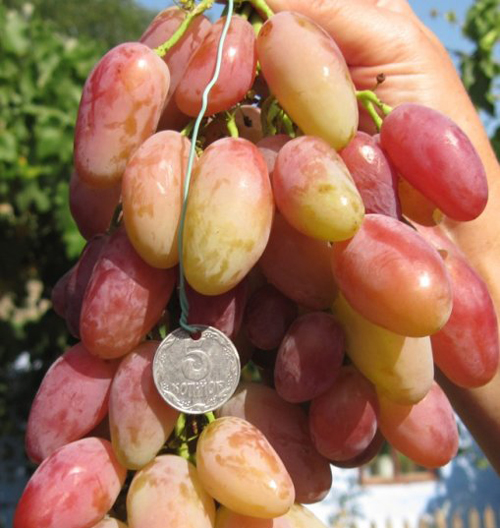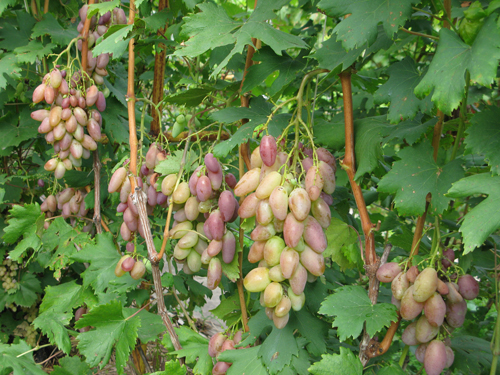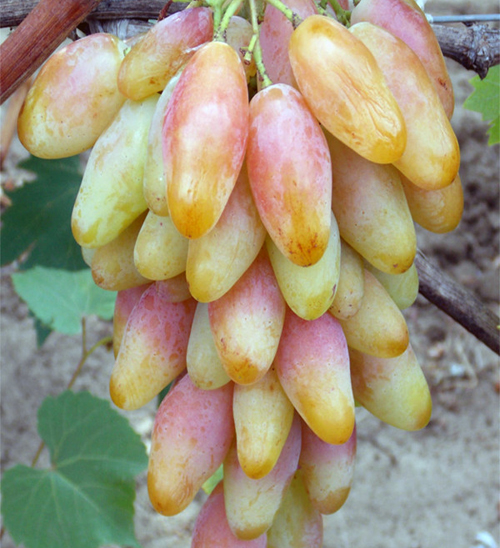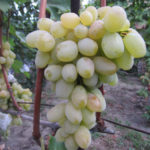Dixon grape variety
Dixon is a hybrid form of table grapes, born in 2014 by the works of A.V. Burdak.

Like many of his other colleagues in the workshop, the life of Alexander Vasilyevich at first was far from professional viticulture, and even more so from research work on the development of new varieties. By profession, he is a drilling rig operator, and for a long time he was engaged in the cultivation of the "sun berry" exclusively on his personal plot. However, with the appearance in the 90s of new promising varieties from amateur breeders of the first wave, Alexander Burdak became interested not only in these hybrids, but also in hybridization itself, which opened up endless scope for creativity. The author has set himself the goal of developing an ideal grape that is attractive in appearance, good taste and crunchy texture, as well as unpretentious cultivation and resistance to common diseases.
One of these attempts to get closer to this ideal, in fact, was Dixon. It was obtained as a result of crossing the hybrid of the Ukrainian Atlant Zaporozhye, which has a functional-female type of flower, with Angelica, a very interesting form of the Russian luminary of amateur selection, Viktor Krainov. Both parents of the novelty are distinguished by a large pinkish berry, and this characteristic was fully passed on to their offspring, which unexpectedly showed, in addition, the original nipple shape of the fruit. When biting through grapes, the crunch, so beloved by the author, is caught, but our hero's resistance to unfavorable environmental conditions turned out to be average.

Of the shortcomings found in some owners, the presence of a certain astringency in the taste of the fruit, and a tendency to shedding the grapes can be noted. Commercial cultivation is also harmed by the average ripeness of a given grape, as a result of which it has to withstand fierce competition in the market with older, inexpensive varieties. In general, Dixon can be called a very picturesque form, not devoid of some specific features, because of which the variety cannot be called perfect.
Agrobiological properties
The bushes show high vigor of growth, due to which the shoots can grow 2-3 meters in length per season. The leaves are large enough, dark green, rounded, consisting of three or five lobes, between which there is a significant dissection. The profile of the leaf blade is flat or slightly wavy, the upper side is coriaceous, reticulate-wrinkled, the pubescence is not noticeable on the reverse side. The upper lateral incisions are deep, most often open in the form of a lyre with a rounded bottom, less often closed with an elongated ovoid lumen. The lower notches are shallow in depth, open with parallel sides, or have the appearance of an inclined angle. The petiole notch is open, lyre-shaped or lancet. Petioles are of moderate length, greenish-red in color due to intense anthocyanin pigmentation. The teeth along the perimeter of the leaf blade are relatively aligned, triangular with convex edges and sharp tops. The flowers are bisexual, capable of perfectly pollinating with their own pollen and forming well-executed clusters without the tendency to pea berries. There are no problems with the ripening of the vine under normal crop load. By the time the brushes are harvested, the shoots are already matured to a sufficient length. At the same time, the color of the vine changes to light brown.

Ripening Dixon clusters have a conical appearance, a loose structure and reach very large sizes. So, the usual brush weight ranges from 600 to 1000 grams. Freely located berries are well ventilated and do not deform from contact with each other. The combs are rather long and strong, herbaceous, colored greenish-pink. Some winegrowers have problems with the fragility of the legs of the berries, due to which they break off and shatter the fruits. Fortunately, this problem is not permanent, and other Dixon owners do not notice similar defects on their bushes. The grapes are characterized by an elongated original shape and color, as well as very large sizes. Their average weight is 15 - 20 grams. The surface is painted in yellowish-pink tones and is covered with a light protective wax coating of medium thickness. The color intensity is variable and depends on many soil and climatic factors. The fruit pulp is distinctly crispy when eaten, quite firm, and has a pleasantly balanced fruit flavor and aroma. The sugar content of grapes is quite high - 18 - 19 g / 100 ml, and the titratable acidity is within the normal range for table varieties - 6 - 7 g / l. The skin is dense, protects the berry well from damage, but at the same time it is easy to chew while eating. There are seeds, but their presence does not particularly spoil the gastronomic experience of grapes. Some owners are negative only by the slight astringency of the berries during tasting.
The use of the harvested crop can be very diverse. First of all, Dixon, attractive in appearance and quite tasty, is intended for fresh consumption. It can also arouse interest among buyers in the market, but farmers do not particularly like varieties like our hero, which ripen at the very peak of competition with old mass varieties and low prices for grapes corresponding to this period. In individual farms, this hybrid is able to take its rightful place in the assortment, which ensures a continuous supply of "sunny berries" to the table. The surplus of a high-yielding form can be successfully used to prepare blanks for the winter. A large, well-retained berry will look great in compotes, jams and marinades, enriching the finished product with excellent taste, aroma, a set of vitamins and minerals.
It is possible to cultivate Dixon grapes in the open field, both in the southern regions of traditional viticulture, and somewhat to the north, where climatic conditions ensure the accumulation of at least 2600 - 2700 ° C of the sum of active temperatures during the spring-summer period. The growing season for our hero is about 125 - 135 days, counting from the day the buds open until the grapes reach the removable maturity. The time of mass harvesting varies depending on the region in which the vineyard is located, but, for example, in the conditions of the Lower Don region, you can start cutting bunches approximately at the end of August. In general, the potential area of distribution of Dikson is limited from the north by the latitude of cities such as Tambov, Oryol or Lipetsk. It should be noted right away that here you should definitely think about the full protection of the planted bushes from winter frosts, because cold resistance of the vine in this form does not exceed −23 ... −24 ° С.
Other economic characteristics of the still very young hybrid are being studied by those amateurs who managed to acquire it on their plots. However, already according to the first reviews, it becomes known about the high yield of the variety. It is facilitated by excellent large-fruiting, demonstrated almost from the first years of fruiting, the ability of the bushes to reach significant dimensions, as well as good fruitfulness of the shoots. To prevent overloads in spring, the bushes are cut into 35 - 45 eyes, shortening the fruit arrows to 7 - 8 buds.With a green fragment, sterile and weak shoots are removed, and before flowering, extra brushes are removed. An insufficient load is no less harmful than an excessive one, because in this case, the plants "fatten", and, according to some winegrowers, they have a tendency to crack the berries. With optimal productivity, this defect practically does not appear in Dixon.








